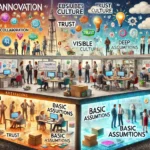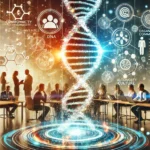Imagine an organization as a garden, where employees are the trees growing within it. Now, the water, soil, and sunlight that nurture these trees represent learning and development. Without it, neither the trees grow nor does the garden remain lush.
Let’s talk about why learning and development are so crucial, how they contribute to individual growth, and what impact they have on an organization’s success.
What is Learning and Development?
Learning and development is a continuous, structured process aimed at:
- Helping employees enhance their knowledge, skills, and capabilities.
- Fostering a culture of growth and advancement throughout the organization.
This process not only makes employees better at their jobs but also gives them a sense of progress toward larger goals.
Why is Learning and Development Important?
1. Maintaining Organizational Competitiveness
The world is changing at the speed of light, and organizations that don’t take learning seriously will fall behind in the competition.
- Example: Emerging technologies like artificial intelligence require employees to continuously update their skills.
2. Increasing Employee Job Satisfaction
When people feel they are growing in their roles, their motivation and job satisfaction increase.
- Example: A sales employee who learns new skills like negotiation or data analysis is likely to feel more engaged with their job.
3. Enhancing Team Performance
Continuous learning enables teams to work more effectively together and execute projects with higher quality.
- Example: Conducting workshops on soft skills like effective communication or conflict resolution.
4. Strengthening Employee Commitment to the Organization
Organizations that invest in employee development are more likely to retain their workforce.
- Example: Training programs that provide employees with a clear career path.
The Learning and Development Process in Organizations
1. Needs Assessment:
The first step is identifying what kind of learning employees and the organization require.
- Example: Do employees need new technical skills, or should they focus on improving communication abilities?
2. Designing Training Programs:
Developing targeted and well-structured training programs.
- Example: Online courses, in-person workshops, or blended learning programs.
3. Implementation and Evaluation:
Delivering training sessions and measuring their effectiveness.
- Example: Assessing whether employee performance has improved after training.
Types of Learning and Development
1. Technical Training:
Training that helps employees gain expertise in specific tasks.
- Example: Learning to use new software or enhancing technical knowledge.
2. Soft Skills Training:
Developing interpersonal skills like communication, time management, and leadership.
- Example: Conducting conflict resolution training for team managers.
3. Leadership Development Programs:
Preparing employees for managerial roles.
- Example: Training future managers to lead larger teams.
4. Project-Based Learning:
Employees enhance their skills and knowledge through hands-on project work.
- Example: Participating in cross-functional projects to learn complexity management.
Challenges in Learning and Development in Organizations
1. Lack of Time:
Employees may struggle to find time for training sessions.
- Solution: Offering short, accessible learning modules like microlearning.
2. Resistance to Change:
Some employees may be reluctant to learn new things.
- Solution: Creating a learning culture and demonstrating the benefits of training.
3. Budget Constraints:
Training programs can be expensive.
- Solution: Leveraging cost-effective online learning platforms and tools.
A Real-Life Example of Successful Learning and Development
A tech company decided to enhance its learning and development initiatives.
- What did they do?
- Conducted a needs assessment and found that employees needed to learn new programming skills.
- Designed online courses and personalized learning paths for each employee.
- The result?
- Employee productivity increased.
- New projects were executed faster and with better quality.
- Employee satisfaction with the organization improved by 25%.
Learning and development aren’t just a necessity for employees; they’re an investment in an organization’s future. When individuals grow and evolve, organizations naturally become stronger and more successful.
What do you think is the best approach to learning and development in organizations? Let’s discuss! 😊











